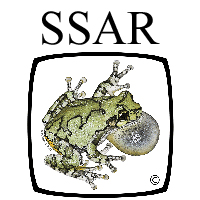Location
SSAR, a not-for-profit (registered 501(c)3) organization established to advance research, conservation, and education concerning amphibians and reptiles, was founded in 1958. It is the largest international herpetological society, and is recognized worldwide for having the most diverse program of publications, meetings, and other activities.
The SSAR Conservation Committee brings conservation issues that affect reptiles and amphibians to the attention of state and federal government agencies, non-government organizations, and herpetologists worldwide. The committee serves as a liaison between the SSAR and public and private groups to provide expert advice, factual knowledge, and educational information about problems confronting amphibians and reptiles, including habitat protection, endangered, threatened, and special concern species, commercial and private use, contaminants, and priorities for conservation-oriented research.
The committee coordinates SSAR responses to proposed national and international legislation and other conservation matters involving reptiles and amphibians. Official responses are submitted for approval by the President and Secretary before public release. Chair submits annual report to Secretary prior to the annual meeting of the Board.
The SSAR also supports numerous grants programs, international exchanges and inter-nation cooperative efforts for study and publications.
Members:
Resources
Displaying 1 - 5 of 5Habitat Selection by the Invasive Species Burmese Python in Southern Florida
Burmese Pythons (Python bivitattus) are large generalist predators that have established an expanding breeding population in Florida. As a first step in understanding current distributions, and therefore spread potential, we assessed diurnal habitat selection by Burmese Pythons in the southern Everglades using radiotelemetry. Sixteen individual pythons were radio-tracked between September 2006 and December 2009. Habitat variables included land cover, habitat edges, surface water depth, and change in water depth.
Relationship between Behavioral Thermoregulation and Physiological Function in Larval Stream Salamanders
Relationships between behavioral regulation, environmental temperatures, and physiological tolerance are critical to conservation policy; however, these relationships may not be consistent among sister taxa. A species geographic range is influenced by various factors including physiological tolerance to temperature change. In this study, we investigated the effects of temperature variation on thermal preference and standard metabolic rates (SMR) of two species of larval salamanders, Eurycea cirrigera (Southern Two-Lined Salamander) and Eurycea wilderae (Blue Ridge Two-Lined Salamander).
Population Ecology of American Crocodile (Crocodylus acutus) in Coiba National Park, Panama
We conducted nocturnal surveys in the insular and coastal areas of Coiba National Park (CNP) and its mainland buffer zone in Panama (Chiriquà conservation site) from 2009â2012 to determine the conservation status of Crocodylus acutus. In 99 nights, we surveyed 147.2 km and captured 185 animals during nocturnal transects inspection with headlamps. Overall, sex ratio was 1.00:1.01 female/male with significant differences by size/age class and year. Females were slightly larger in total length than males (115.1 ± 56.9 cm-females, 105.4 ± 71.8 cm-males).
Do Ponds on Golf Courses Provide Suitable Habitat for Wetland-Dependent Animals in Suburban Areas? An Assessment of Turtle Abundances
Golf courses represent a common type of anthropogenically modified habitat in suburban environments. Golf courses may provide suitable habitat for semi-aquatic animals in suburban areas, yet studies comparing animal abundances in golf course ponds with other pond types in suburban environments are somewhat limited. In this study, we compared turtle abundances in golf course ponds with ponds found in residential areas and ponds found in rural (farm) areas and examined the relationship between turtle abundance and residential land-cover within individual golf courses.
Fish Influences on Amphibian Presence and Abundance in Prairie and Parkland Landscapes of Minnesota, USA
Many amphibian populations are declining, and increased understanding of the drivers of amphibian presence and abundance will help in their conservation. In 2005 and 2006 we estimated relative abundance of larvae of two common amphibian taxa, Tiger Salamanders (Ambystoma tigrinum) and ranid tadpoles (Northern Leopard Frog Lithobates pipiens and Wood Frog Lithobates sylvaticus), in 75 shallow lakes in prairie and parkland areas in Minnesota.


